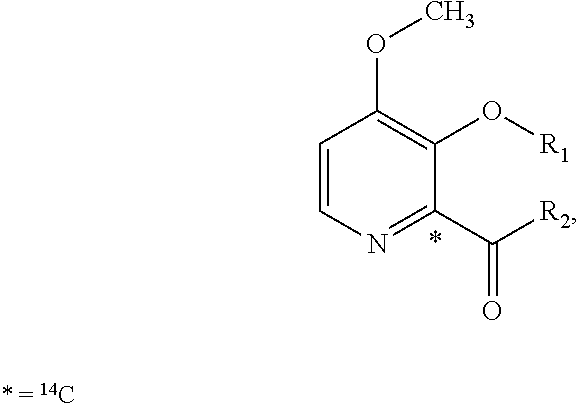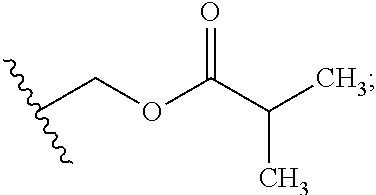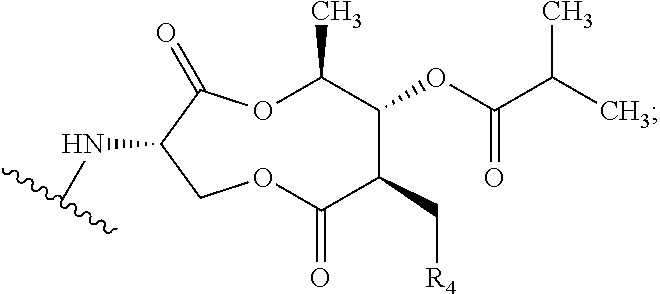Synthesis and use of isotopically labeled macrocyclic compounds
a macrocyclic compound and isotopically labeled technology, applied in the field of preparation and use of isotopically labeled compounds, can solve the problems of sometimes extremely difficult chemical or in some instances, the biosynthesis of properly labeled bioactive molecules
- Summary
- Abstract
- Description
- Claims
- Application Information
AI Technical Summary
Benefits of technology
Problems solved by technology
Method used
Image
Examples
example 1
, Step 8
Preparation of (3S,6S,7R,8R)-8-benzyl-3-({[4-methoxy-3-{[(2-methylpropanoyl)oxy]methoxy}(2-14C)pyridin-2-yl]carbonyl}amino)-6-methyl-4,9-dioxo-1,5-dioxonan-7-yl2-methylpropanoate (Compound 9)
[0102]To a dry 50 mL round bottom flask equipped with magnetic stirrer and N2 inlet was charged (3S,6S,7R,8R)-8-benzyl-3-({[3-hydroxy-4-methoxy(2-14C)pyridin-2-yl]carbonyl}amino)-6-methyl-4,9-dioxo-1,5-dioxonan-7-yl 2-methylpropanoate (479.5 mg, 0.928 mmol) and anhydrous acetone (20 mL). To this solution was added powdered sodium carbonate (Na2CO3; 98 mg, 0.928 mmol) and the mixture was stirred at room temperature for 10 min, treated with iodomethyl isobutyrate (233 mg, 1.02 mmol) dropwise via syringe, and the reaction mixture was stirred at ambient temperature under N2 for 18 h. The acetone solution was filtered through a small plug of SiO2 and the filtrate was concentrated to dryness by rotary evaporation. The crude yellow foam (765 mg) was dissolved in CH2Cl2 (2 mL) and purified by fl...
example 2
, Step 6
Preparation of {[4-methoxy-2-({(3S,7R,8R,9S)-9-methyl-8-[(2-methylpropanoyl)oxy]-2,6-dioxo-7-[(13C6)phenylmethyl]-1,5-dioxonan-3-yl}carbamoyl)pyridin-3-yl]oxy}methyl 2-methylpropanoate (Compound 14)
[0109]A solution of (3S,6S,7R,8R)-3-{[(3-hydroxy-4-methoxypyridin-2-yl)carbonyl]amino}-6-methyl-4,9-dioxo-8-[(13C6)phenylmethyl]-1,5-dioxonan-7-yl2-methylpropanoate (273 mg, 0.531 mmol) in anhydrous acetone (4 mL) was treated with powdered potassium carbonate (325 mesh K2CO3, 147 mg, 1.06 mmol). The slurry was treated with a solution of iodomethyl isobutyrate (145 mg, 0.637 mmol) in acetone (2 mL) while stirring at room temperature under N2. After stirring for 5 h, the reaction mixture was filtered through a plug of Celite® and the plug was washed with EtOAc (30 mL). The filtrate was washed with H2O (2×10 mL), washed with brine (1×10 mL), and the organic phase was dried over Na2SO4, filtered and concentrated in vacuo to give 0.445 g of a light yellow oil. The oil was purified by f...
example 3
, Step 3
Preparation of {[4-methoxy-2-({(3S,7R,8R,9S)-9-methyl-8-[(2-methylpropanoyl)oxy]-2,6-dioxo-7-[phenyl(UL-14C)methyl]-1,5-dioxonan-3-yl}carbamoyl)pyridin-3-yl]oxy}methyl 2-methylpropanoate (Compound 17)
[0113]A solution of UK-2A-(UL-14C)Ph (294 mg, 0.571 mmol) in anhydrous acetone (8 mL) was treated with powdered K2CO3 (111 mg, 0.800 mmol, 325 mesh). The resultant mixture was treated with a solution of iodomethyl isobutyrate (156 mg, 0.686 mmol) in acetone (2 mL) while stirring at room temperature under N2. After stirring for 17 h, the reaction mixture was treated with an additional 33 microliters (μL) of iodomethyl isobutyrate (0.143 mmol, 25 mol %). After an additional 4 h, HPLC analysis showed little change. The reaction mixture was filtered through a plug of Celite® / silica gel, washing with EtOAc, and the filtrate was concentrated in vacuo to give a light-yellow foam (0.497 g). The crude material was purified by flash chromatography (SiO2, 0→25% EtOAc / CH2Cl2) and the purifi...
PUM
| Property | Measurement | Unit |
|---|---|---|
| temperature | aaaaa | aaaaa |
| temperature | aaaaa | aaaaa |
| mol % | aaaaa | aaaaa |
Abstract
Description
Claims
Application Information
 Login to View More
Login to View More - R&D
- Intellectual Property
- Life Sciences
- Materials
- Tech Scout
- Unparalleled Data Quality
- Higher Quality Content
- 60% Fewer Hallucinations
Browse by: Latest US Patents, China's latest patents, Technical Efficacy Thesaurus, Application Domain, Technology Topic, Popular Technical Reports.
© 2025 PatSnap. All rights reserved.Legal|Privacy policy|Modern Slavery Act Transparency Statement|Sitemap|About US| Contact US: help@patsnap.com



